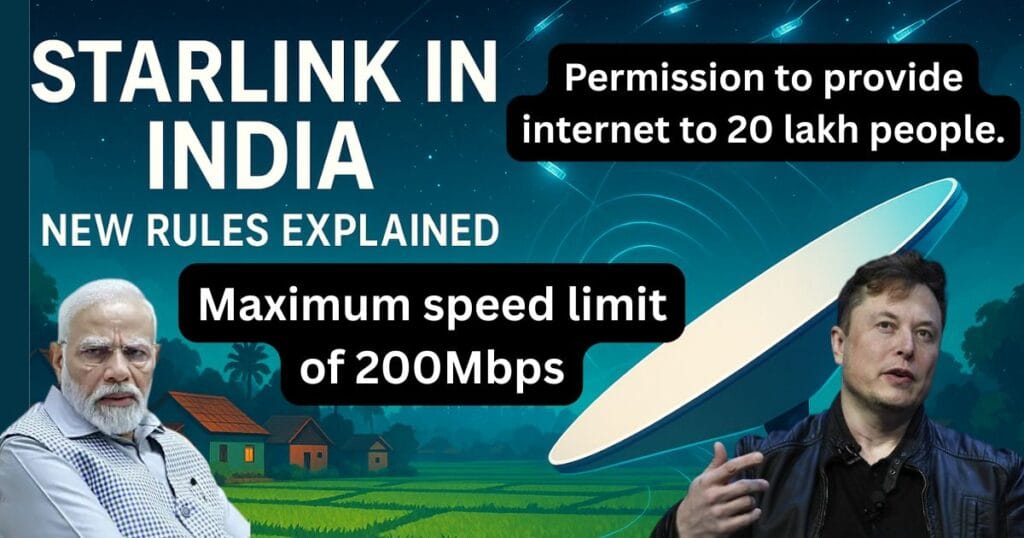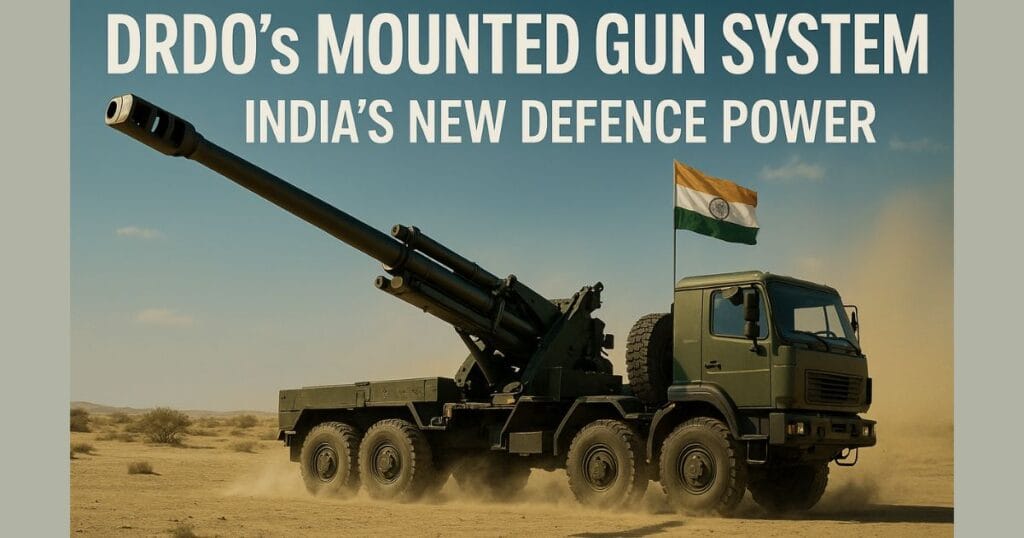Elon Musk’s company Starlink is preparing to provide fast internet via satellite in India, but the Indian government has imposed some strict rules on it. These rules include allowing Starlink to provide internet to only 20 lakh people and a maximum speed limit of 200Mbps. This can bring a big change especially for those villages and remote areas where internet facility is less. But the Indian government has recently imposed some rules on Starlink, which can affect the way it works. In this article, we will explain that what these rules are, why they were imposed, and what impact they will have on the people of India and digital development.

What regulations did the government impose on Starlink?
The Indian government has imposed two major rules on Starlink.
Limit of 20 lakh people- Starlink can provide its internet service to only 20 lakh people in India. That is, out of the country’s 140 crore population, only 0.15% people will be able to use its internet.
200Mbps speed limit- Starlink’s internet will provide a maximum speed of 200 megabits per second (Mbps). This speed is fine for common people, but may be less than providers like Jio and Airtel.
Apart from this, Starlink will have to give 4% of its earnings to the government. If someone takes its internet in urban areas, then he may have to pay an additional fee of Rs 500 every month. This fee will not be charged in villages. These rules came when Starlink got approval to start work in India in July 2025.
Why did the government make these rules?
The Indian government has imposed these rules for several reasons. Let us understand them in simple language.
- Security of the country- Some time ago, some people in Manipur were misusing Its equipment. The government had shut down the internet there, but due to Its equipment, people were able to break that ban. This made the government worried that its misuse could become a threat to the security of the country.
- Saving Indian companies- Companies like Jio and Airtel are already providing internet in India. If it gets full freedom, then these companies may lag behind in the competition. Therefore, the government set a limit on it, so that Indian companies remain strong.
- Data privacy- The government wants Starlink to keep the data it collects in India in the country itself. This will keep people’s personal information safe.
- Control of spectrum- It needs radio waves (spectrum) to run the internet. The government has made strict rules for this, such as paying 8% license fee and minimum spectrum fee every year.
What does the limit of 20 lakh people mean?
The limit of 20 lakh people means that it can provide internet to only 20 lakh homes or people in India. This limit will have an impact in many ways.
For common people- If a lot of people want to use its internet, this limit will be filled quickly. This means that many people who want to use its internet will not get a chance.
Impact on villages- There is a huge lack of internet in the villages of India. Starlink could provide fast internet there, but due to the limit of 20 lakh, only a few villages will benefit. For example, even if half the connections go to the villages, only 10 lakh people will be able to use it.
Impact on cities- There are many options like Jio and Airtel in the cities, so this limit will not make much difference there. People can easily take other services.
200Mbps speed: Is it enough?
A speed of 200Mbps means you can watch videos, play games, and work on the internet faster. But is it enough for India? Let’s understand this by comparing it with other services.
| Service | Minimum Speed | Maximum Speed | Starting Price (Per Month) |
|---|---|---|---|
| Starlink | 200 Mbps | 200 Mbps | ₹3000 (~$36) |
| JioFiber | 30 Mbps | 1 Gbps | ₹399 |
| Airtel Xstream | 40 Mbps | 1 Gbps | ₹499 |
In cities- Jio and Airtel offer speeds up to 1Gbps (1000Mbps), which is much higher than Starlink’s 200Mbps. If you live in a city and want very fast internet, Starlink may be a bit weak.
In villages- Internet speeds in villages are usually less than 10-20Mbps. 200Mbps will make a big difference there. This will allow people to study online, do video calls, and other things easily.
Is it enough- 200Mbps is enough for most people. This is a good speed for HD video streaming, online gaming, and general tasks. But if you download a lot of data or many people use the internet simultaneously, then faster plans from Jio or Airtel may be better.
Starlink’s journey so far in India
Starlink has recently received permission to start work in India. Let’s understand its journey.
- Approval- In July 2025, Starlink got the final approval to start work from the Indian National Space Promotion and Authorization Center (IN-SPACe). Earlier in June 2025, it got a special license (GMPCS) from the Department of Telecommunications, which is for 5 years.
- Equipment status- So far Starlink has not installed any internet terminals (which catch signals from satellites) in India. The company has planned to install earth stations (large equipment on the ground) at some places, which will take data from the satellite and deliver it to the people.
- When will it start? – Starlink can start its services in India in late 2025 or early 2026. It will benefit the most in villages and remote areas, where there is a lack of internet.
Will these rules impact India’s digital growth?
The Government of India’s Digital India program wants the Internet to reach every corner of the country. Starlink can help fulfill this dream, but there may be some obstacles due to these rules.
- Internet in villages- In villages where the internet is very weak, Starlink’s 200Mbps speed can change people’s lives. With this, people will be able to e-asily get online studies, telemedicine (talking to the doctor on video call), and government services.
- Limited impact- Due to the limit of 20 lakh people, Starlink will not be able to make much impact across the country. If only a few people are able to take advantage of it, then it may be difficult to achieve the goal of Digital India.
- Education and health- Starlink can promote online education and telemedicine in villages. For example, children will be able to take online classes and patients will be able to consult a doctor sitting far away.
What other services are there besides Starlink?
If you can’t access the internet due to Starlink’s limitations, there are other options in India.
- OneWeb- This company is providing satellite internet in collaboration with Bharti Airtel. It is working especially in villages and remote areas.
- Jio SpaceFiber- Reliance Jio and a company named SES have started this service together. It is also focusing on providing internet in villages.
- Traditional Broadband- Options like JioFiber and Airtel Extreme are already available in cities, which provide fast and cheap internet.
Government and private companies: regulations versus new technology
There is always a balance to be struck between the government and private companies. On the one hand, the government wants the country to be safe and local companies to be strong. On the other hand, companies like Starlink want to bring in new technology.
Security first- Starlink provides internet from satellite, which is difficult for the government to control. If it is misused, like it happened in Manipur, then the security of the country can be at risk.
Opportunity for Indian companies- If Starlink is given complete freedom, then companies like Jio and Airtel may lag behind. Therefore, the government-imposed limits on Starlink, so that Indian companies can also survive in the market.
Welcome to new technology- Companies like Starlink can change the world of internet in India. But the government has to ensure that these companies follow the rules of the country.
Official Starlink
Will there be more stringent rules in the future?
Yes, there is a possibility of more stringent rules coming in the future.
- Data privacy- The government would like Starlink and other companies to keep all the data in India. This will ensure data privacy and security.
- Licensing rules- If companies like Jio and OneWeb expand their satellite internet services, the government may become stricter on foreign companies.
- Spectrum charges- Starlink may have to pay more for radio waves, which could make its services more expensive.
ALSO READ- Starlink in India: High-Speed Internet Launch, Pricing, Speed & Benefits
Conclusion: The future of satellite internet in India
Despite these regulations, the future of satellite internet in India is bright. Services like Starlink, OneWeb, and Jio SpaceFiber can bring internet to villages and remote areas. This will allow people to access online education, healthcare, and government schemes. Even though the 20 lakh limit and 200Mbps speed limit pose some obstacles, satellite internet will make India digitally stronger. In the coming years, as technology and regulations improve, internet access and speed in India will increase further.
Starlink can change the world of internet in India, especially in villages. But its impact may be limited due to government regulations. Still, satellite internet will play a big role in turning India’s digital dreams into reality.
Do you want to know more about Starlink or satellite internet? Comment below and let us know what you think about these rules! Subscribe to our blog to keep getting the latest technology and internet news.
Why has the Indian government imposed new rules on Starlink?
The Indian government introduced new rules for it to ensure national security, protect local telecom companies, and maintain control over internet infrastructure. Incidents like the misuse of Starlink equipment in Manipur during an internet ban raised concerns about potential threats. Additionally, to ensure fair competition, the government aims to prevent Starlink from overpowering Indian providers like Jio and Airtel. The rules also mandate data privacy and spectrum regulation, requiring Starlink to store data within India and pay specific licensing fees.
What do the 20 lakh user and 200Mbps speed limits mean for Indian consumers?
It is allowed to serve only up to 20 lakh users in India, which is just 0.15% of the total population. This means access will be limited, especially as demand grows. The 200Mbps speed cap is decent for most daily activities like streaming, video calls, and online education. However, it may fall short compared to urban fiber services offering up to 1Gbps. These limits may restrict Starlink’s overall impact, particularly in urban areas, although rural regions with weaker internet may still benefit significantly.
Will Starlink help bridge the digital divide in India despite the restrictions?
Yes, to some extent. Despite the user and speed restrictions, Starlink can be a game-changer in rural India, where traditional broadband is scarce or unavailable. Its satellite-based internet can deliver reliable connectivity for remote education, telemedicine, and government services. However, the 20 lakh user cap may limit widespread adoption. To fully support India’s Digital India mission, broader access and policy flexibility may be needed in the future.
Do you want to know more about Starlink or satellite internet? Comment below and let us know what you think about these rules! Subscribe to our blog to keep getting the latest technology and internet news.


